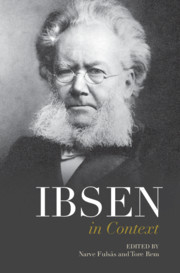Book contents
- Ibsen in Context
- Ibsen in Context
- Copyright page
- Contents
- Figures
- Contributors
- Preface
- Notes on the text
- Chronology
- Part I Life and Career
- Part II Culture and Society
- Chapter 4 Genres
- Chapter 5 Realism
- Chapter 6 Theatre
- Chapter 7 Visual Arts
- Chapter 8 Music
- Chapter 9 Philosophy
- Chapter 10 Science
- Chapter 11 Feminism
- Chapter 12 Capitalism
- Part III Scandinavian Reception
- Part IV Internationalization
- Part V Afterlives
- Further Reading
- Index
Chapter 7 - Visual Arts
from Part II - Culture and Society
Published online by Cambridge University Press: 23 April 2021
- Ibsen in Context
- Ibsen in Context
- Copyright page
- Contents
- Figures
- Contributors
- Preface
- Notes on the text
- Chronology
- Part I Life and Career
- Part II Culture and Society
- Chapter 4 Genres
- Chapter 5 Realism
- Chapter 6 Theatre
- Chapter 7 Visual Arts
- Chapter 8 Music
- Chapter 9 Philosophy
- Chapter 10 Science
- Chapter 11 Feminism
- Chapter 12 Capitalism
- Part III Scandinavian Reception
- Part IV Internationalization
- Part V Afterlives
- Further Reading
- Index
Summary
Ibsen, who originally wanted to be a painter, came of age at a time when theatre and painting were still considered closely connected art forms. Throughout most of the nineteenth century, painters would paint scenes from plays, and playwrights would create plays inspired by paintings. In their salons, the aristocracy admired pictorial performances known as ‘attitudes’ or ‘living sculptures’ and staged tableaux vivants, theatrical enactments of famous paintings. The constant interaction between the ‘sister arts’ created an aesthetic environment in which it felt natural to think about paintings in dramatic terms and about drama in painterly terms. Thus Ibsen was inspired by painters such as the English Pre-Raphaelites and the Swiss Arnold Böcklin.
Throughout his career, from relatively early works like ‘Terje Vigen’ and Peer Gynt to modern plays like The Wild Duck, The Lady from the Sea, Hedda Gabler, John Gabriel Borkman and When We Dead Awaken, Ibsen included traditional painterly tableaux in his works. But modernism swept away the idea of ‘sister arts’. Although Ibsen never abandoned his traditional understanding of painting, this chapter shows that in his contemporary plays his traditional visual aesthetics emerges as a seamless part of a new, radically modern vision.
- Type
- Chapter
- Information
- Ibsen in Context , pp. 55 - 64Publisher: Cambridge University PressPrint publication year: 2021

